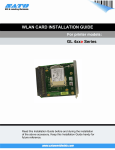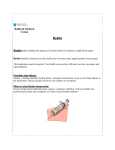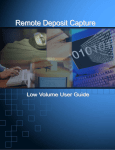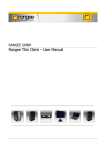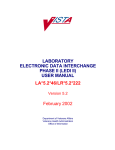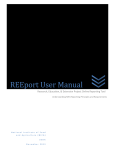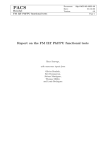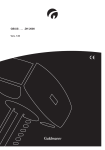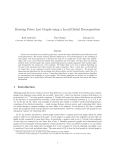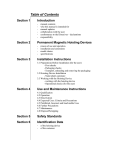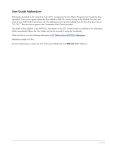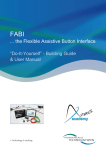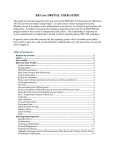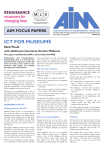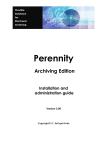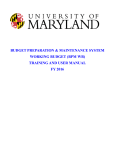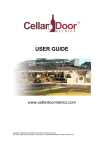Download pdf1,8mb - Michael
Transcript
Michael Technical Documentation and User manual June 2014 MICHAEL 2.0 Technical documentation and user manual June 2014 1/46 Michael Technical Documentation and User manual June 2014 Versions Date 17/06/2014 Version 1 NB Marie-Véronique Leroi (Training session) 2/46 Michael Technical Documentation and User manual June 2014 I. Introduction The purpose of this manual is to provide you with some information about the Michael software, how to manage it and how to create and manage collections and institutions desciptions within the Michael software. This manual brings together documentation achieved during the Michael projects (MICHAEL and MICHAEL Plus) and user manual proper to the Michael 2.0 version based on the Eprints software1. This documentation does provide some information on how to install and customize a national instance but it also contains some information on how to create a collection description and how to manage one institutions’ records. II. About Michael MICHAEL is the Multilingual Inventory of Cultural Heritage in Europe. The principle of Michael is to have a European portal that harvests collections descriptions from national instances. Datamodel and terminologies have been defined on a common basis in order to facilitate the interoperability between national instances and European portal. At first, Michael was a project funded within the eTen program that started with three main partners (2004-2006). The Michael network has then be extended to 15 partners within the MICHAEL Plus project (2006-2008). MICHAEL consists in a repository of multilingual collections descriptions. Digital collections are the core of Michael and related institutions, services, and physical collections are inventoried in order to provide a complete collection description. The strenght of Michael relies on the fact that the datamodel and terminologies used for managing the European portal and the national instances are exactly the same so the technical interoperability at national and European level is automatic. Michael also relies on standards like Dublin Core and OAI-PMH. III. About the software The Michael software was formerly based on SDX and Xdepo softwares which are no longer maintained. In 2013, the Eprints software solution has been chosen for the Michael European portal and national instances. 1 Eprints : http://wiki.eprints.org/w/Entire_Manual 3/46 Michael Technical Documentation and User manual June 2014 EPrints3 is a generic repository building software developed by the University of Southampton. It is intended to create a highly configurable web-based repository. EPrints is often used as an open archive for research papers, and the default configuration reflects this, but it is also used for other things such as images, research data, audio archives anything that can be stored digitally. Eprints is distributed as an open source tool and can be downloaded from its website : http://www.eprints.org/ The required software to run Eprints are the common Apache (HTTP Web server), MySQL (realtionnal database), Perl (language scripts), GDOME (Gnome Document Object Model Engine). An ongoing evolution is to integrate a Lucene search engine to the core Eprints software. Eprints supports natively the OAI-PMH protocol and enables to create, modify and publish very easily records. Eprints offers many interesting features in comparison to the Michael 1.0 sofware which make the general software management and the cataloguing process easier. IV. Installing Michael 2.0 The installation of the Michael 2.0 software follows the basic installation steps of the Eprints software. You can refer to the Eprints online manual for more precisions on Eprints installation : http://wiki.eprints.org/w/Installation After the core Eprints has been installed and configured with the required softwares (Apache, MySQL, Perl, GDOME), some complementary files should be placed in the Eprints repositories and some specific scripts should be ran in order to implement the Michael proper datamodel, terminologies and interfaces. Please note that as a national instance manager, you will not have to install the Michael 2.0 on your own and on your server. All the national instances will be installed and managed by the Michael Culture Association. V. Collection description As mentioned previously the digital collection description is the core of Michael. Before going in depth through the platform, here is a reminder of what a collection description is2. Collection Description is a great way for museums, libraries and archives to share information about their digital services with a worldwide audience. The MICHAEL system is designed to help institutions to: 1. Describe the content of their digital collection 2 « Michael Collection Description, © The Museums, Libraries and Archives Council, 2007 4/46 Michael Technical Documentation and User manual June 2014 2. Describe the services (the websites) they have created 3. Publish this information in a searchable format that will be available to tourists, researchers, students and thousands of others. But before of speaking of collection description it is better to define what is a collection. Indeed each profession has its own view on what is a collection. For example, if you work in a library, your approach to collections will depend on which kind of library you work in to an extent. If you are an archivist, it is likely that you have experience of working at fonds level instead of with collections. For those working in museums, collections are a familiar concept, but a fluid one as a single object may appear in a number of different collections that may be defined thematically, by collector or by other interpretations. For the purposes of Collection Description, UKOLN defines a collection as: « A collection is an aggregation of physical and/or electronic items. e.g. library collections; museum collections; archives; library, museum and archival catalogues; digital archives; Internet directories; Internet subject gateways; collections of text; images; sounds; datasets; software etc. A collection may be made up of any number of items from one to many. » For our purposes, it is important to be fairly flexible in thinking about what does, and does not constitute a collection. The main aim is to bring together information about groups of items in a way that can be used to help people to access collections. Collections: • Are groupings of physical or electronic items • Exist throughout museums, libraries and archives • Described to improve access The Dublin Core Metadata Initiative Working Group on Collection Description offers the following definition: « The term 'collection' can be applied to any aggregation of physical or digital items. It is typically used to refer to collections of physical items, collections of digital surrogates of physical items, collections of 'born-digital' items and catalogues of such collections. Collections are exemplified in the following, non-exhaustive, list: • Library collections • Museum collections • Archives • Library, museum and archival catalogues • Digital archives • Internet directories and subject gateways • Web indexes • Collections of text, images, sounds, datasets, software, other material or combinations of these (this includes databases, CD-ROMs and collections of Web resources) • Other collections of physical items » 5/46 Michael Technical Documentation and User manual June 2014 VI. The Michael datamodel In this section of the manual we remind the basis of the Michael datamodel. The following description takes its source from the original document describing the Michael datamodel3. The data model is composed of five entities, or five different data structures, one for each kind of record you wish to create: digital collections, institutions, programmes or projects, services or products, physical collections. When we talk about the digital collection entity, we thus mean the record type digital collection, or the data structure suitable for digital ollections. A record is one manifestation of an entity, to represent an actual thing. For instance, in order to describe the institution Bibliothèque nationale de France, we will create one record of type institution, or one concrete manifestation of the entity institution. Entities are thus abstract concepts, and records are real objects in the system. Surely, records must be linked between each others. For instance, it is not enough to have on one hand a description of the Bibliothèque national de France and, on the other hand, a description of one of its digital collection. The system – and at the end the user – must know that this particular institution has created the digital collection, for instance. This is called a relation, and a relation is always made between two records, and not between two entities; relations are between real objects, not abstract concepts. Having entities, records and relations is not enough to fully define the data model. We need to know how to describe a specific entity, for instance an institution: name, address, and so on. These characteristics of an entity will be called fields in this data model. An entity is thus a collection of fields. 1) Entities For each entity, we give a definition and mention any mandatory relationships between entities. A mandatory relationship means that to publish some information in the system, it must have a specific relationship to another entity (not seeAlso). For instance, if the relationships between digital collection and institution are mandatory, it means that a digital collection record is not completed and may not be published without a relation to at least one institution. 3.5 Digital Collections The digital collection entity is the main focus of the Michael project as it aims at being an inventory of digital and digitized cultural heritage. A digital collection may be a set (or group) of digital items or a set of records describing digital items. A digital collection may be a set of digital images, texts, structured data, sound files, virtual reality models, multimedia or other resources. The collection may be aggregated on one server or distributed across several servers. In MICHAEL all digital collections relate to aspects of the European cultural heritage, Digital collections are at the heart of the MICHAEL project. The other entities are offered to provide for additional descriptive or reference information for the digital collection, without duplication. 3 th MICHAEL data model, version 1.0, 30 September 2005 6/46 Michael Technical Documentation and User manual June 2014 Digital collections have mandatory relationship with an institution or one service/product. 3.5 Institutions An institution is an agent that owns digital collections, is responsible for digitisation projects, funding programmes, or for developing and managing information services or products. Institutions may include museums, libraries, archives and others with an interest in the digital cultural heritage. Institutions have a mandatory relationship with either a digital collection, or a physical collection, or a project or a service/product in the MICHAEL system. 3.5 Services or Products A service (or product) is a point of access to a digital collection or collections. It may consist of an online or an offline service (such as an application that enables users to select and order copies from a collection on demand) or it may consist of a packaged product that presents all or part of one or more collections (such as an electronic learning resource). Services or Products are included in the MICHAEL system to offer users with information about how and where to digital collections. This entity is recommended; A service or product has a mandatory relationship to at least one digital collection or one institution in the MICHAEL system. 3.5 Projects or Programmes A project or programme involves one or more institutions and directly or indirectly results in the creation of either digital collections or services/products. This entity is included to provide a useful reference for institutions and is optional in the MICHAEL system. A project or programme has a mandatory relationship to at least one institution or one digital collection. It is recommended practice that there should be a relationship to an institution. 3.5 Physical Collections A physical collection is a set of physical items, for example a set of museum objects, or a set of physical archives or a library collection. The aim of MICHAEL is not to build inventories of physical collections. This entity is provided for reference to physical collections that have given birth to digital collections, for example through digitisation. This is an optional entity in the MICHAEL system. A physical collection has a mandatory relationship to at least one institution and either a digital collection or a project/programme. 2) Relations As explained previously, there will be relations between records in a MICHAEL inventory. Basically, a relation is a link between two records. This link has some special characteristics: 7/46 Michael Technical Documentation and User manual June 2014 • It has a role, either chosen from a predefined list or an ad hoc role. • It may have a description, explaining to humans the exact nature of this role. In MICHAEL, we decided that link doesn't have a specific direction. If, for instance, there is a relation between an institution and a digital collection, it also means that there is a link from the institution to the digital collection, and a link from the digital collection to the institution. For instance, if an institution is responsible for a digital collection, then the reverse is also true: the digital collection is under the responsibility of the institution. The MICHAEL data model defines a set of specific relations between records of certain types. In this document, we will define these relations using the five entities, but please recall that relations are really between records, not between entities, in an actual system. Mandatory relationships between entities are defined in the previous section. 3.5 Relations involving digital collections A digital collection... • May be under the responsibility of an institution • May be created in the context of a project or programme • May be created by an institution • May be a representation of all or part of a physical collection • May be made available via a product or service • May be part of another (larger) digital collection 3.5 Relations involving institutions An institution... • May be responsible for digital collection(s) • May be responsible for physical collection(s) • May be the location of a physical collection • May be responsible for or may contribute to programmes / projects • May be responsible for products / services • May create a product or service • May be part of another (larger) institution • May create a digital collection 3.5 Relations involving projects or programmes A project or programme... 8/46 Michael Technical Documentation and User manual June 2014 • May be the responsibility of an institution • May be contributed to by an institution(s) • Project may be part of a programme • Programme may be concerned with funding projects • Project may be part of another project • May create a digital collection • May create a product or service 3.5 Relations involving services or products A service or product... • Makes available (part of) one or more digital collections • May be created by an institution • May be under the responsibility of an institution 3.5 Relations involving physical collections A physical collection... • May be under the responsibility of an institution • May be located at an institution • May be created in the context of a project or programme • May be created by an institution • May be the source of part or all of a digital collection or collections • May be part of another (larger) physical collection 3) Fields The following sections contain reference definitions of fields for each entity. For each field, we provide first its name, then its code – a computer name used in the XML schema – and then we give information whether the field is mandatory or not. As a matter of fact, three values are permitted: 1. mandatory: the field must be present in order to validate a record 2. optional: the field may be present in a record 3. recommended: the field should be present, although in some circumstances it can be omitted if not relevant 9/46 Michael Technical Documentation and User manual June 2014 Following these basic information, you will find a short description of the field, complete enough to understand its role and purpose. In this reference document, technical fields are omitted. These fields are, for instance, the filename or URL of an image, the last modification date, etc. They are part of the XML schema, but are omitted here since they do not bring anything to the understanding of the data model for humans. 3.5 Entity Digital Collection Section Identification Identifier [identifier – mandatory] This is the identifier for the digital collection. This identifier plays an essential role in the MICHAEL system. All entities should have a unique identifier, and this identifier should also be unique in the scope of the European instance. Title [title – mandatory] The title of the digital collection. The title should provide a meaningful point of reference to the digital collection, and preferably it should be unique, at least within an institution. Acronyms and abbreviations should not be used in this field. Section Identification Description [description – mandatory] A free text description of the digital collection. This should add to the information provided in the title. Language [language – recommended] The language of the material contained in the digital collection. Digital format [digital-format – recommended] The digital characteristics of the collection. More specific than the digital type. Digital type [digital-type – recommended] This is the general type of digital collection, for example: a collection of texts, a collection of images, a collection of interactive resources, a collection of sound files. N.B. Includes virtual collections. Content type [content-type – optional] This is the type of content in the digital collection. For example, maps, music scores or manuscripts. Size [size – optional] An evaluation of the size of the collection. This is intended to provide information for users of the MICHAEL system about the size of the digital collection. Accrual [accrual – optional] 10/46 Michael Technical Documentation and User manual June 2014 A statement of accrual policy (closed, passive, active, partial/selective), accrual method (purchase, deposit) and accrual periodicity (closed, irregular, periodic). This information is especially important for harvesting purposes, to foresee the evolution of aggregated resources. Standard [standard – optional] A statement of any descriptive or terminology standards that were used in creating the item level metadata associated with the digital collection. Legal status [legal-status – mandatory] A statement of the legal status of the digital collection. Access control [access-control – optional] A statement of any access restrictions that are placed on the collection. This would be used where for example access to the collection is closed for a period of time or where access is restricted to a certain category of users. The information is not intended for public use, but for reference by the institution that owns or manages the collection. Related database [database – optional] Database describing the objects in the collection. Section Subject Subject [subject – mandatory] The subject or concept of the items in the digital collection. Lists of subject keywords will be provided. Spatial coverage [spatial-coverage – recommended] The spatial coverage of the items in the digital collection. An international list of countries and régions will be used in the MICHAEL system to provide the basis for multi-national searches. More detailed lists of regional and local administrative areas and places will be provided for each national instance. Period [period – mandatory] The general period(s) spanned by the content of the digital collection, for example Neolithic or Bronze Age. Start date [start-date – optional] This is the approximate date of the earliest item in the digital collection expressed as a year. For example, this would be 1400 for collections that date from the ‘Fifteenth Century’. End date [end-date – optional] This is the approximate date of the latest (or most recent) item in the digital collection expressed as a year. For example, this would be 1699 for collections that date from the ‘Seventeenth Century’. 11/46 Michael Technical Documentation and User manual June 2014 Culture [culture – optional] Culture or people that are the subject of the digital collection, for example Islamic or Jewish. Famous people [famous-people – optional] Famous (or interesting) people specially concerned with the digital collection. The aim of this field is to record outstanding individuals. It should not be used to record all known people who are associated with the collection. Famous event [famous-event – optional] Famous (or interesting) events specially concerned with the digital collection, for example Waterloo. The aim of this field is to record outstanding events. It should not be used to record all known évents that are associated with the collection. Famous place [famous-place – optional] Famous (or interesting) places specially concerned with the digital collection, for example Mont Fuji. The aim of this field is to record outstanding places. It should not be confused with the spatialcoverage field and must not be used to record all known places that are associated with the collection. Famous object [famous-object – optional] Famous objects or star items specially concerned with the digital collection. This field is particularly intended for use by small and medium cultural institutions. It should be used where there are one or two exceptional items in the collection that would not otherwise be found by subject indexing. It should not be used to provide a list of all items in the collection. Section Illustration Illustrations provide sample data, usually images but could be any media. We only provided here non technical field definitions. Illustrations are optional; when we say that, for instance, the illustration title is mandatory, it is only mandatory if there is an illustration. Title [title – mandatory] The title of the illustration. Creator [creator – optional] The creator or originator of the illustration, such as a photographer who captured an image. Legal status [legal-status – mandatory] A statement of the rights associated with the illustration. 3.5 Entity Institution Section Identification Identifier [identifier – mandatory] 12/46 Michael Technical Documentation and User manual June 2014 This is the identifier for the institution. This identifier plays an essential role in the MICHAEL system. All entities should have a unique identifier, and this identifier should also be unique in the scope of the European instance. Name [name – mandatory] The name of the institution. The name of the institution should be provided in full. Acronyms and abbreviations must not be used. Acronym [acronym – optional] This is the acronym (or abbreviated form of an institution’s name) that is commonly used to identify an institution. For example, the ‘Museums, Libraries and Archives Council’ is commonly abbreviated to the acronym ‘MLA’. Acronyms should be recorded where they exist and are commonly used. They should not be created for the purpose of entering data in the MICHAEL system. Acronyms may or may not form part of the Institution Identifier. Jurisdiction [jurisdiction – optional] The organisation the institution is affiliated to or sponsored by. For example, the ministry that funds an institution. Logo [logo – optional] A link to an image file that contains the Institution’s logo. Section Description Institution type [institution-type – recommended] This is the general activity or sector in which an institution operates, for example archive, museum, library, local community and other. Administrative status [administrative-status – recommended] The general administrative status of the institution, for example public, commercial or nonprofit making. Section Location This section contains address information. An address is an aggregation of the fields that follow, and at least one address must be provided. Street [street – recommended] This is a generic field used for the street, the name of a building, the name of a department, room number etc. PO Box [pobox – optional] This is the PO box number. Locality [locality – recommended] The locality is the smallest administrative area, which is usually a town, city, ward, village or a commune, etc. 13/46 Michael Technical Documentation and User manual June 2014 Postal code [postal-code – recommended] This is the post-code., for example in the United Kingdom W1A 1AA. Region [region – recommended] Region is a general concept, and can be any administrative area that is larger than a locality but smaller than a country. In the United Kingdom, region may include a devolved administration, a government region or a county. In France it may include a region or a département and in Italy a region or province. Country [country – mandatory] This is the country part of the address. Section Communications Telephone number [telephone – optional] This is the general telephone number for the institution, for example the number of the switchboard or for a help/information desk. The international dialling code must be included in the telephone number to support international use of the MICHAEL system. Fax number [fax – optional] This is the general fax number for the institution, for example the number of the switchboard or for a help/information desk. The international dialling code must be included in the telephone number to support international use of the MICHAEL system. Email [email – recommended] This is the general email address for the institution, for example the address for a help/information desk. URL [url – recommended] This is the URL of the home page for an institution. Section Contact Person Agent name [agent-name – optional] This is the name of the agent or service (for example a department within an organisation). Agent telephone [telephone – optional] This is the contact telephone number for the agent or service (for example a department within an organisation). The international dialling code must be included in the telephone number to support international use of the MICHAEL system. Agent fax number [fax – optional] This is the contact fax number for the agent or service (for example a department within an organisation). The international dialling code must be included in the telephone number to support international use of the MICHAEL system. Agent email [email – optional] This is the contact email address for the agent or service (for example a department within an organisation). 14/46 Michael Technical Documentation and User manual June 2014 3.5 Entity Service or Product Section Identification Identifier [identifier – mandatory] This is the identifier for the service or product. This identifier plays an essential role in the MICHAEL system. All entities should have a unique identifier, and this identifier should also be unique in the scope of the European instance. The identifier could consist of a country code followed by a unique identifier for the product or service. Title [title – mandatory] This is the name of a service or product. This should provide reference to the type of service or product that is being provided. It may consist of: • title by which the service is known, e.g. the title of a website, or • the name of the collection plus the type of access that is being provided, for example: ‘The works of Caravaggio: CD-ROM’, or • the type of access, for example a print on demand service. Section Description Description [description – recommended] This is a short description of the content of a product or service and the functions that are being provided. It should add to the information provided in the title. For example “this website allows users to search and browse the collections database of the Museum”. It should not replicate the description of the content of the collection. Language [language – mandatory] The language(s) in which the product or service is made available. Maintenance [maintenance – optional] This is a general indication of the maintenance status of the product or service, for example ongoing (live), complete, regular update and so on. Audience [audience – recommended] The intended audience for whom the product or service has been designed. Legal status [legal-status – recommended] A statement of the legal status of the product or service. Section Access Conditions Access type [access-type – mandatory] This is the general type of service or product that is available. This should include online, offline, hard-copy, print-on-demand and so on. Accessibility [accessibility – optional] A statement of the characteristics of the service or product that make it accessible to users. For example the availability of a speech enabled browser (for an offline service). 15/46 Michael Technical Documentation and User manual June 2014 WAI [wai – recommended] This is the level of conformance to WAI specifications of the service or product, for example A, AA, AAA. Access conditions [access-conditions – mandatory] This is a general indication of any conditions on access to the service or products, for example free, charged for, restricted etc. Comment on access conditions [comment-access-conditions – optional] This is a brief note, or comments, providing more information about conditions for access to the service or product. Section Technical Information Technical requirements [technical-requirement – optional] This is a brief description on the technical requirements for accessing a service or product. For example the plug-ins that a user would require to use a service. Technical description [technical-description – optional] This is a link to an external description that provides information about how a remote access service is configured, such as the available inputs and outputs. For example, a link to the specification for an institution’s Z target. Protocol [protocol – optional] This is the communication protocol, for example Z39.50, OAI-PMH, ZING, etc. Output format [output – optional] This is the output format from a service, for example the output format of an OAI target might be XML. Section Access Location Description of access location [access-location/description – optional] This is a short description of the means of accessing a service or product. In the case of an analogue product or an off-line service, it is recommended that all of the relevant information should be provided in this field. Access locator [access-location/locator – recommended] A locator, such as an URL, of the access-point for the service or product. 3.5 Entity Project or Programme Section Identification Identifier [identifier – mandatory] This is the identifier for the project or programme. This identifier plays an essential role in the MICHAEL system. All entities should have a unique identifier, and this identifier should also 16/46 Michael Technical Documentation and User manual June 2014 be unique in the scope of the European instance. This could consist of a country code followed by a unique identifier for the project. Title [title – mandatory] This is the title of a project or programme. This should be written in full. Acronyms and abbreviations must not be used as the aim is to provide information that is understandable to a general audience. Acronym [acronym – optional] This is the acronym (or abbreviated form) of the project or programme title. This acronym should be commonly used, it must not be created simply for the MICHAEL system. Logo [logo – optional] A link to an image file that contains the project or programme’s logo. Section Description Description [description – recommended] This is a short description of the project or programme, which should add to the information that is provided in the title. Digitisation process [digitisation-process – optional] This is a general indication of the technical features of the project or programme, and of the digitisation processes used. This may be direct or indirect etc. Funding type [funding-type – optional] This is a general indication of the type of funding that supports the project or programme, for example internal, external and so on. Section Communications Email [email – optional] This is the general email address for the project or programme, for example the address for a help/information desk. URL [url – optional] This is the URL of the home page for a project or programme. Section Progress Start date [start-date – recommended] This is the approximate starting date of the project or programme. This may be expressed as a year. Completion date [completion-date – optional] This is the approximate date when the project or programme ended, where this is known. This may be expressed as a year. Project status [project-status – optional] This is a general indication of the status of the project or programme, for example planned, 17/46 Michael Technical Documentation and User manual June 2014 on-going, completed. Section Contact Person Agent name [agent-name – optional] This is the name of the agent. Agent telephone [telephone – optional] This is the contact telephone number for the agent. The international dialling code must be included in the telephone number to support international use of the MICHAEL system. Agent fax number [fax – optional] This is the contact fax number for the agent. The international dialling code must be included in the telephone number to support international use of the MICHAEL system. Agent email [email – optional] This is the contact email address for the agent. 3.5 Entity Physical Collection Section Identification Identifier [identifier – mandatory] This is the identifier for the physical collection. This identifier plays an essential role in the MICHAEL system. All entities should have a unique identifier, and this identifier should also be unique in the scope of the European instance. Title [title – mandatory] The title of the physical collection. The title should provide a meaningful point of reference to the physical collection, and preferably it should be unique, at least within an institution. Acronyms and abbreviations should not be used in this field. Section Description Description [abstract – recommended] A free text description of the physical collection. This should add to the information provided in the title. Language [language – optional] The language of the material contained in the physical collection. Physical format [physical-format – recommended] The physical characteristics of the collection. Size [size – optional] An evaluation of the size of the collection. This is intended to provide information for users of 18/46 Michael Technical Documentation and User manual June 2014 the MICHAEL system about the size of the physical collection. Accrual [accrual – optional] A statement of accrual policy (closed, passive, active, partial/selective), accrual method (purchase, deposit) and accrual periodicity (closed, irregular, periodic). This information is especially important for harvesting purposes, to foresee the evolution of aggregated resources. Standard [standard – optional] A statement of any descriptive or terminology standards that were used in creating the item level metadata associated with the physical collection. VII. Getting started The screenshot above represents the homepage of a Michael national instance. The menus on the left are presented as an accordion and provide some contextual information on the Michael portals and the Michael Culture association. The Help menu provides contextual help for the general user who is browsing or searching for collections throught the portal. The ‘Static Reserved Area’ is the central zone for the cataloguers as the functionnalities for administrating the instances and collections will be accessible from there. The cataloguer will have to connect to the Michael instance with his credentials in order to be able to create and manage his instution collections. For each national instance, an administrator has been designated. Each instance is then responsible for the users and workflow to apply for their instance management. 19/46 Michael Technical Documentation and User manual June 2014 The general user can access the content in different ways as there are many browsing possibilities (subjects, period, …) and also a simple and advanced search. VIII. Connecting to the Michael Instance To connect to the Michael instance, you have to select the ‘LOGIN’ option available from the Static Reserved Area on the left menu. As mentionned in the previous section, each national instance has a respository administrator. An email address should be provided for each user in order to enable notifications. If the user has forgotten his password, he can reset it by clicking on the corresponding link. The user will then receive an email asking to modify the password. As visible on the screenshot, cookies must be enabled in order to have a persistent session once logged in and not being interrupted during a collection description. IX. Items and workflow The Michael 2.0 has a different terminology and worksflow for the creation, management and publishing of collections. The Epints software a strong user management and workflow which allows an efficient collaborative and intuite management of repositories. Here follows some terminology elements : 20/46 Michael Technical Documentation and User manual June 2014 Term Synonym Description Represents the file containing the description of a Item Record digital collection, an institution, a service or a physical collection The record is no more an item in the user workarea Deposit an item Validate a record but a valid record that will be reviewed before publishing Once the record has been validated (deposited) and reviewed it can be published and will then be Move to repository Publish a record visible and gets an URL A record that has been published (moved to Move to review Unpublish a record repository) can be unpublished and get through a review. The URL will not be functionnal anymore Unpublish and delete a record that were created Remove an item Delete a record and/or published The schema below represents the general workflow for the creation and publishing of a record (item). There can different steps for a same item before it is finalised and published (=moved to the repository). When the item has been reviewed and published it is still possible to retire the item : it will not be under review nor as a draft in the user workarea. The only way to deal 21/46 Michael Technical Documentation and User manual June 2014 with a retired item is either to move it to the repository where it can be removed completely if not relevant. A published record is a live archive and gets an URL that can be accessed directly thanks to the unique identifier of the item. Once an item is retired or removed after being published, the URL is no longer available. X. User management 1) User roles The Michael instance can handle three different user roles : User, Editor and Repository Administrator. The user is the role with the least of priviledges. On the contrary the repository administrator is the one who can manage globally all the records and content from the instance but also the static and editorial content. The table below summarizes the rights and actions for each user role : Roles Category General administration User management Collections management Actions Change/update structural texts of the instance interface Change/update static content Create user Delete user Attribute user rights Create items Use an item as a template Create a new version of the item Edit items Deposit items Remove items Remove items with notifications Move items to review Move to repository Return items Change owner Retire items Repository Administrator Editor User X X X X X X X X X X X X X X X X X X X X X X X X X X X X X X X X X X X The User can create and manage items by depositing them but can not publish them or delete them. The work of a User is meant to be reviewed and supervised by an Editor. The repository administrator who has more rights than the other users is the one who supervised the general administration of the repository and ensure the consistency of the database. 22/46 Michael Technical Documentation and User manual June 2014 2) Creating a user To create a user, you have to be logged in as a Repository Adminsitrator. Then as shown on the screenshot above, select the ‘ADMIN’ link on the left menu (1), then select the ‘System Tools’ Tab (2) and click on the ‘Create User’ button (3). Then you can define a Username : Once you have defined the Username and clicked on the ‘Create User’ button, you will access to a Web form asking for details about the newly created user. 23/46 Michael Technical Documentation and User manual June 2014 All the mandatory field are specified by the orange asterisk. The Repository Administrator has to define the type of user for the new user. The Username filled in in the previous form is presented again in this form. Eprints offers the possibility to customize the user roles predefined within Eprints. The ‘Roles’ block is intended to give more rights or to be more restrictive with the default rights of a User or an Editor. However customisation of the user roles is possible, we do recommend the default organisation and user management. 24/46 Michael Technical Documentation and User manual June 2014 The screenshot above shows you which information are asked when creating a new user. 25/46 Michael Technical Documentation and User manual June 2014 Once the new user details have been saved, the Repository Administrator can have a preview of the user details with the metadata of the creation of the user and his ID. XI. Interfaces and page editing There are two ways of managing the texts and labels available on the interface of your national instance. The menu and editorial static pages of your national instance can be customised/updated directly without manipulating any technical system files. Some elements are part of the Eprints system and then have to be managed directly thanks to a configuration file that can be modified with a graphical user interface. These elements are mainly all the structural elements (title of menu, help texts, fields name, …). The other elements are the content from the static pages. These elements can also be changed directly from the GUI. In both cases to proceed with this customisation, you have to be logged in to the instance as a Repository Administrator. 1) Structural elements 26/46 Michael Technical Documentation and User manual June 2014 The structural elements of your national instance are all grouped in a single configuration XML file ‘zz_webcfg.xml’. Most of the content available consist in the labels for the menu and the general structure of your instance but also the contextual help. The content of this file can be modified via the interface. Follow the following steps to modify/translate the phrases of your instance : 1. Log in as a repository administrator 2. Go to the ‘ADMIN’ section from the Static Reserved Area (1) 3. Select from top of the header the language you would like to work on. 4. Once connected, different tabs are available for the administration of your national instance: select the ‘config. Tools’ tab (2) and click on the ‘Phrase Editor’ button (3). 5. Now you can edit and modify all the phrases used in your instance. 27/46 Michael Technical Documentation and User manual June 2014 6. For each modification, click on the save button so it can be taken into account. You can click on reset to restore the default value of the field. 7. If your national instance is available in more than one language you can modify the texts and labels for each language via the same GUI. Please note that the modifications done will be applied only for the language set on top of the header ; if you want to translate all/some of the phrases in the other languages available you will have to choose the language and then do the modifications. 2) Static elements If you intend to modify the non structural elements which are the static ones, you will also have to be logged in as a repository administrator. Follow the steps below to change/update the content of a static page : 1. Go to the static page that you want to modify ; 28/46 Michael Technical Documentation and User manual June 2014 2. Click on the ‘Edit Page’ link available under the ‘Static Reserved Area’ as in the screenshot below 3. Then you will have two possibilities to change the content. - Either you use an external editor so you can work offline and use a more convenient editor (Notepad, Wordpad, VI or Emacs) : in this case you will have to export the HTML file, do the modifications and upload the file back. - Or you use the embedded HTML editor visible on the screenshot below. In this case you will have to do the modifications and click on the ‘Save changes’ to update the page. 29/46 Michael Technical Documentation and User manual June 2014 4. Refresh the page to see that the updates have been well taken into account. Please note that to make an update of these static pages a basic knowledge of the HTML Markup Language is necessary. 30/46 Michael Technical Documentation and User manual June 2014 When you make modifications on the phrases of the instance via the ‘Phrase Editor’ (zz_webcfg.xml file), all the changes will be saved on the XML file but you will have to edit a static page as described above and save it (even without any modification) to see the modifications done on the phrases. If you are willing to restructure the menus on the left for example adding a new page under an existing menu or creating a new left menu, please note that it cannot be done via the user interface. You will have to contact the Michael technical team with a request for reorganising the content and then you will be able to manage the content if the new pages and menus created. XII. Collections management You have seen in the section IX on Items and Workflow, Michael 2.0 has a different worksflow and steps to create records. Although the datamodel and the terminology defined during the project are still the same. We present in this section how to create the different entities supported byt he Michael DataModel (see section VI). 1) Creating a new item The screeshot above presents you how to procede to create a new item. First log in as a User, an Editor or a Repository Administrator and then select the ‘Manage deposits’ link from the ‘Static Reserved Area’ left menu (1) and click on the ‘New Item’ button. 31/46 Michael Technical Documentation and User manual June 2014 Then you have to select the type of the entity which can be one of the entities from the Michael DataModel. The selection of one or another item type will propose the corresponding Web form. You can see on the top of the screenshot how many steps are remaining for the creation of the item. These steps are common to each entity. 2) Creating a digital collection 32/46 Michael Technical Documentation and User manual June 2014 The first form as presented in the screenshot above asks for details on the digital collection. For most f the field it is possible to add more input rows and specify the language which 33/46 Michael Technical Documentation and User manual June 2014 could be very useful if you already have or are planning to have multilingual collection description at national level. The fields where selection is possible are based on terminology lists of Michael. The screenshot above consists in the third step of the creation of the item and is related to the subjects used to index the collection. You will have to select the small blue ‘Add’ button to add a subject. Once it is selected it will appear on top of the corrsponding block. Click on the small blue ‘Remove’ button to remove the subject. 34/46 Michael Technical Documentation and User manual June 2014 The Upload step allows you to include images, sound or video files to illustrate your collection description. Michael 2.0 allows you to upload not only images but also multimedia files therefore the Web form proposes you to select a ‘document’. In this item creation context, a document is an image, a sound file , a video or any file that comes along with the collection description The document can be selected from local folder or from the Web with a psecific URL. The order of the documents can be managed as well as the metadata of these documents. The Following screenshot shows the Web form asking metadata on the documents. These metadata can be quite complete and are vey useful to prevent possible IPR issues on the documents connected to the collection. 35/46 Michael Technical Documentation and User manual June 2014 The screenshot below presents the Contacts and Custom step for the creation of the Item. The contacts step is new to the collection description within Michael 2.0 but the fields are not mandatory and can be left empty. These contact details can be relevant in the case of two insitutions cooperating for the digitisation of a collection and the contact details might be the one of the second insitution while the first one will be the creator of the collection. 36/46 Michael Technical Documentation and User manual June 2014 The Custom section is crucial since it is the place where the relations from and to the collection are managed. It is not possible to browse the list of Institutions or other entities so you will have to keep track of the different identifiers created when you create a new collection. In order to ensure the migration process properly we have kept track of the SDX ID which was the identifier created within the first Michael software. The new collections created within Michael 2.0 will not have this SDX ID. The screenshot above shows you the final step for the creation of digital collection but this frame is common to each entity of the Michael DataModel. 37/46 Michael Technical Documentation and User manual June 2014 You can see that you can still deposit an Item even if all the mandatory fields have not been filled in, but you will not be able to move it to the repository (=publish). 3) Creating an Institution In this section follow the screenshots of the form for the creation of an institution. 38/46 Michael Technical Documentation and User manual June 2014 The final steps ‘Custom’ and ‘Deposit’ are the same for each item as mentionned in the previous chapter. 4) Creating a Service In this section follow the screenshots of the form for the creation of a service. 39/46 Michael Technical Documentation and User manual June 2014 40/46 Michael Technical Documentation and User manual June 2014 5) Creating a Project In this section follow the screenshots of the form for the creation of a project. 41/46 Michael Technical Documentation and User manual June 2014 42/46 Michael Technical Documentation and User manual June 2014 The ‘Contacts’, ‘Custom’ and ‘Deposit’ steps are the same than presented before. 6) Creating a Physical Collection In this section follow the screenshots of the form for the creation of a physical collection. 43/46 Michael Technical Documentation and User manual June 2014 The ‘Contacts’, ‘Custom’ and ‘Deposit’ steps are the same than presented before. 44/46 Michael Technical Documentation and User manual June 2014 7) Managing the created items User Workarea The items that have been just created are stored in the User Workarea. You can access to your items from the ‘Manage deposits’ link on the left menu. For each item, you can see what its status is. The items which are still on the workarea are in yellow and proposes to view, remove, edit and deposit the item. Review Once an item has been deposited it is sent under review. Only the Repository Administrator and the Editor can review items. The items to be reviewed can be accessed from the ‘Review’ link on the left menu. Then the Repository Administrator and the Editor will have the possibility to View, Edit, Return with notifications, Delete and Move to the repository the item. You can see on the screenshot above that the items get an ID while sent to review. This ID will be used to create the URL from which the item will be available and functions as an URI. 45/46 Michael Technical Documentation and User manual June 2014 Move to Repository This icon allow you to publish your records, eg. move your items to the repository. Then you will have a preview of your item with a notification mentionning that your item is now a « Live archive ». You can see in the screenshot above all the functionnalities available for a repository administrator to manage his item once it has been published. You can refer to the section « Items and Workflow » to see the general workflow of Michael 2.0. XIII. Conclusions This manual is a work in progress as many features are to be developped such as the OAI format for harvesting or being harvested and possibilities for graphical customization. But you have here a first glimpse at Michael 2.0 functionnalities. 46/46














































